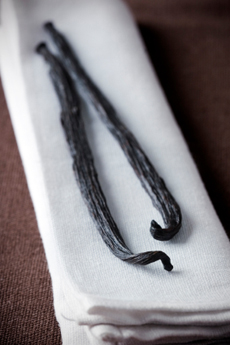
 Vanilla is the second costliest spice in the world, after saffron. Photo of vanilla beans by Joan Vicent Canto | IST.
|
|
|
MARISSA GOLDBERG is a graduate of the Institute For Culinary Education.
|
|
November 2008
Updated March 2009
|
 |
Vanilla: The World’s Favorite Flavor
Page 1: Vanilla Overview ~ It’s Hardly “Plain Vanilla”
CAPSULE REPORT: The United States is the largest consumer of vanilla beans, using around 1,200 tons per year. Most of them are made into vanilla extract. Even if you buy pure vanilla extract—not the artificial stuff, which is a fraction of the price—all pure vanilla extract is not created equal. Even when you buy the finest brands, there’s a big variation—and you can tell the difference, as you’ll see in this article. We sourced the best, and baked it into shortbread cookies and panna cotta. If you love to bake, or otherwise cook with vanilla, join us on this journey. You’ll learn about the different types of vanilla products—beyond beans and extracts), how to buy vanilla, the best brands. We’ll even share the recipes of the shortbread and panna cotta. And, we’ll tell you where you can buy the products, which make great gifts for your friends who bake. Real vanilla products make up just a fraction of the market. An astonishing 97% of all vanilla products are synthetic, made of paper by-products! Artificial vanilla has been around since the late 19th century. But, tempting as it is to save money, there’s nothing like the real thing, as you’ll see in this article. This is Page 1 of a ten-page article. Click on the black links below to visit other pages.
Introduction
Vanilla seems all too common. The flavoring is in our ice cream, our birthday cakes, our puddings…or so we thought. The truth is that vanilla is often misrepresented. Visions of a white and plain confection with a nondescript flavor have essentially supplanted the authentic beauty of vanilla—with its deep, mahogany color and radiantly aromatic flavor.
Much “vanilla flavored” food is not made with real vanilla, but with imitation vanilla flavor. Artificial vanilla is ubiquitous, because real vanilla is the second-most expensive spice on earth, after saffron.
Real vanilla comes from a beautiful, celadon-colored orchid, native to Mexico and discovered, along with chocolate, by the Spanish conquistador Hernán Cortés, who brought it back to Europe in 1527 or 1528. (See the History Of Chocolate Timeline.) The Totonac Indians of Mexico were the first to cure and use the fruit (and they do so to this day); when they were conquered by the Aztecs, they were forced to give up their secret methods.
Vanilla was used in Mexico as an offering to the gods and to flavor the beverage cacao (chocolate). It continued to be used for the latter purpose when Cortés brought the ingredients back to the Old World. In 1602, Hugh Morgan, apothecary to Queen Elizabeth I, suggested that vanilla could be used as a flavoring all by itself; the versatility of the flavor spread quickly among the wealthy (the only people who could afford chocolate and vanilla) and demand began to increase. Thomas Jefferson is credited with introducing vanilla to the United States in the late 1700s. He became familiar with vanilla while serving as U.S. minister to France from 1785 to 1789, at the court of King Louis XVI. When he returned to the U.S., he brought 200 vanilla beans with him (and the first U.S. pasta-making machine, as well).
Today, vanilla beans are grown in four main regions of the world, each produces vanilla beans with distinctive characteristics and attributes. Madagascar, an island off the east coast of Africa, is the largest producer of vanilla beans in the world and the ensuing vanilla is known as Madagascar Bourbon vanilla. The term Bourbon applies to beans Madagascar and neighboring Comoro, Réunion and Seychelles. There is no connection with the liquor produced in Kentucky in the United States. Madagascar Bourbon vanilla is considered to be the highest quality pure vanilla available, described as having a creamy, sweet, smooth, and mellow flavor.
Continue To Page 1a: The Vanilla Orchid
Go To The Article Index Above

|
|




 Vanilla is the second costliest spice in the world, after saffron. Photo of vanilla beans by Joan Vicent Canto | IST.
Vanilla is the second costliest spice in the world, after saffron. Photo of vanilla beans by Joan Vicent Canto | IST.